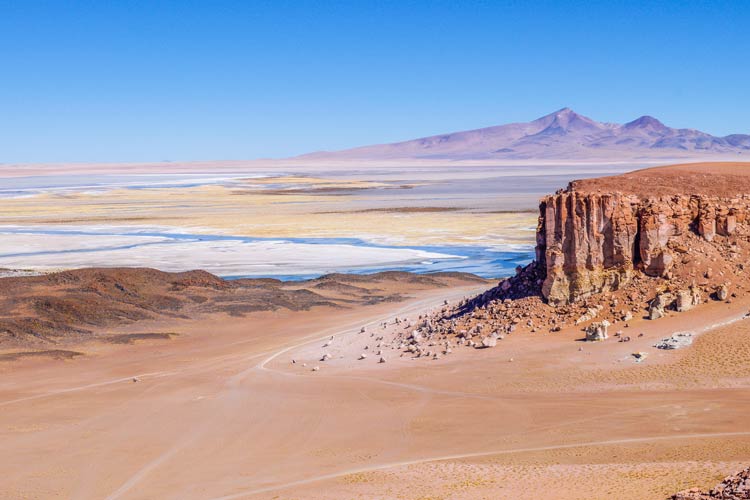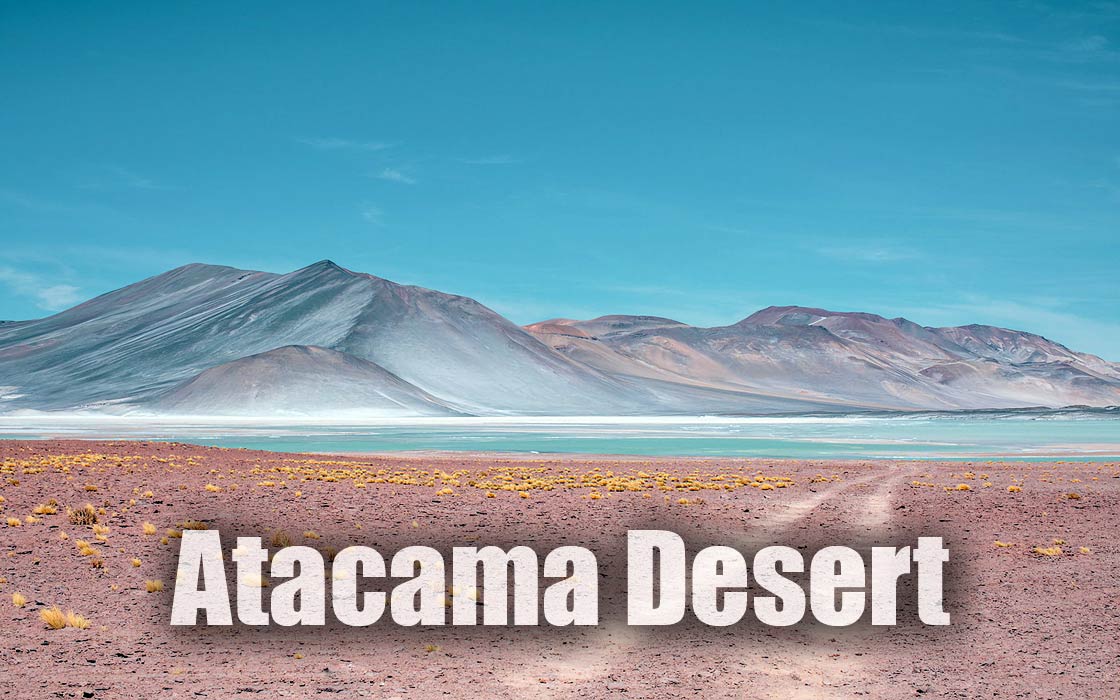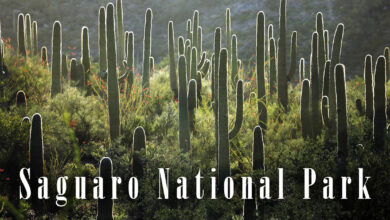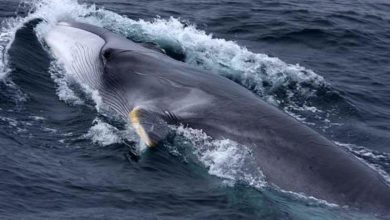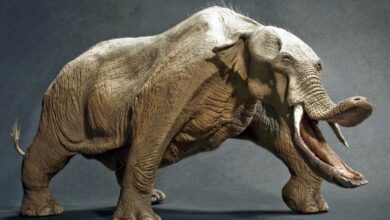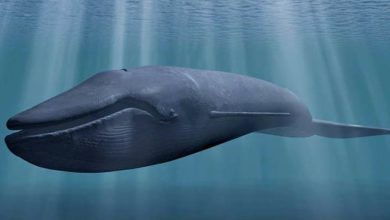Atacama Desert – a Land Without a Drop of Rain
Let us imagine a place where the earth cracks with thirst and the horizon stretches into infinity, painting a landscape in shades of rust, ochre, and grey. The Atacama Desert, hidden in the shadow of the Andes, is one of the most inhospitable and fascinating places on Earth. The Atacama is a fog* desert. It is a land that seems to exist outside of time – dry, harsh, and yet full of mysteries that attract scientists, travelers, and dreamers. Let us prepare for a journey into the depths of this extraordinary world, where nature tests the limits of life, and the landscape resembles an alien planet.
*A fog desert occurs in places where the edges of a continent are washed by cold ocean currents, which causes the formation of fog. These fogs are often the only source of moisture in these areas, as rainfall is very rare there.
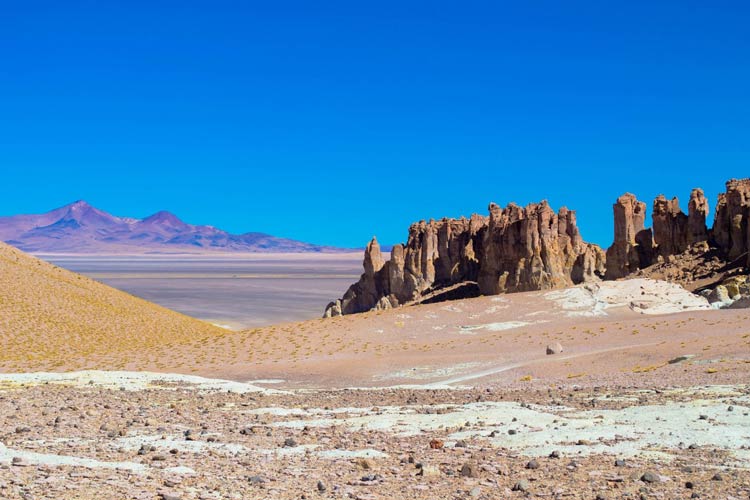
Location
Sliver of Earth Between Mountains and Ocean
The Atacama Desert stretches across northern Chile, encompassing a narrow strip of land between the mighty Andes mountain range to the east and the vast Pacific Ocean to the west. It covers an area of approximately 105,000 km2 (40,541 square miles), extending also into southern Peru and western Bolivia.
Its boundaries are defined by dramatic contrasts: from coastal cliffs, where the fog called camanchaca rises above the waves, to the high plateaus of the Andes, reaching over 4,000 meters (13,123 feet) above sea level. This location makes the Atacama one of the most isolated places on Earth – cut off from moisture by the mountains and ocean currents, it remains almost completely devoid of rain.
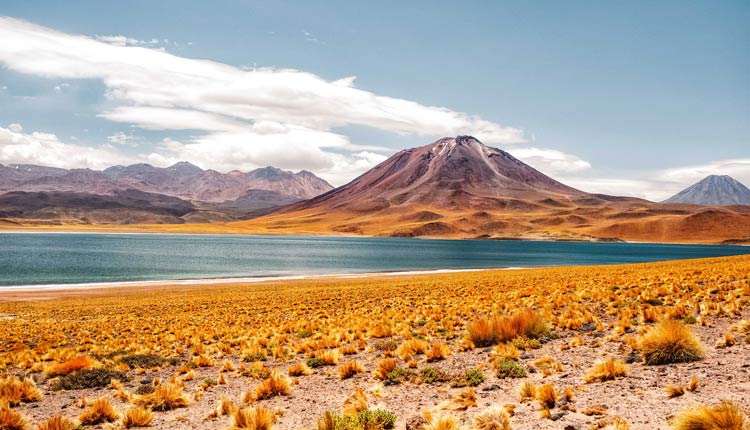
Geology
Traces of Ancient Cataclysms
Beneath the surface of the Atacama lies Earth’s history written in rocks and minerals. The desert sits at the junction of tectonic plates – the South American and the Pacific – making it a witness to millions of years of geological dramas. Volcanic cones, such as Licancabur and Láscar, dominate the landscape, reminding us of the seismic activity that continues to shape this region.
The Atacama is also a treasure trove of raw materials: rich deposits of copper, lithium, and nitrate attract industry, but it is salt – ubiquitous, white, and crunchy underfoot – that defines its surface. In some places, layers of salt form surreal formations, as if nature were sculpting its own works of art here. Geologists also find fossils of marine organisms here, evidence that millions of years ago the desert was the ocean floor – today it is a dry relic of a former world.
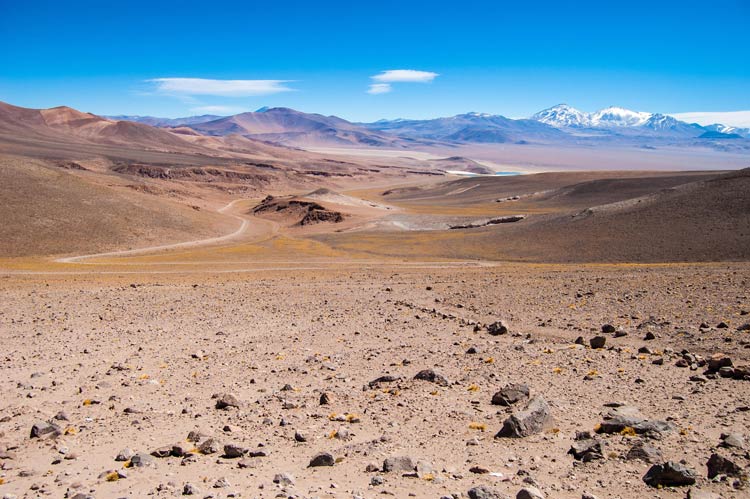
Climate
The Driest Place on Earth
If there is a place that could rival the definition of drought, it is the Atacama. In some parts of it, such as around the city of Arica, it has not rained for over 400 years. The average annual rainfall here is less than 1 millimeter (0.04 inches) – for comparison, the Sahara receives several dozen times more.
The reason? Its location in the rain shadow of the Andes blocks moist air masses from the Amazon, and the cold Humboldt Current cools the coast, preventing ocean evaporation. Temperatures fluctuate extremely: during the day they can exceed 30°C (86°F), only to drop below freezing at night; nevertheless, due to its location far from the equator, it is a cold desert, with average temperatures of 18-19°C (64-66°F). The camanchaca fog, rising from the ocean, is the only source of moisture, but even it rarely reaches deep into the desert. It is a climate that seems to say: “There is no room for weakness here.”
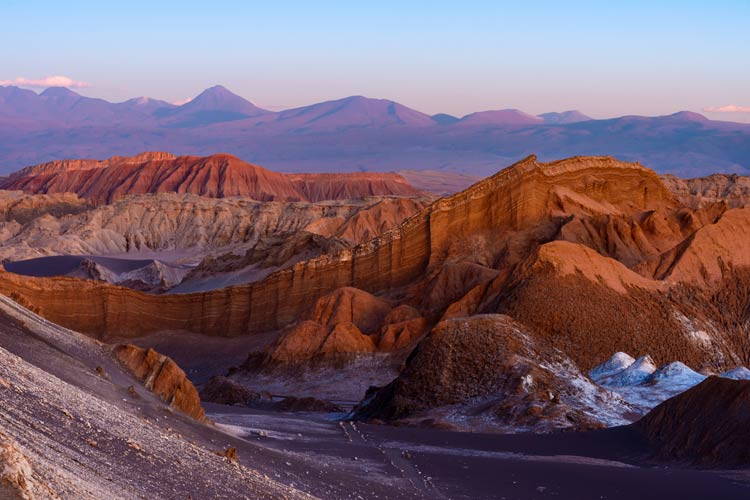
Comparison with Mars
Earth’s Testing Ground for the Red Planet
Looking at the Atacama, it is easy to understand why NASA scientists chose it as a testing ground for Martian rovers. The reddish, dusty soil, the lack of vegetation, and the extreme dryness make the desert look like a landscape from another planet. The soil of the Atacama is rich in chemical compounds, such as perchlorates, which are also found on Mars, and its surface remains almost untouched by water erosion.
In 2003, researchers discovered microorganisms living in extreme conditions here – bacteria that survived in the salty, dry soil, giving hope for finding life on the Red Planet. The Atacama is not just a desert – it is a window to space that allows us to imagine what Martian everyday life might look like.

Extreme Weather Phenomena
Sandstorms and Flowers in the Desert
Although rain is rare here, the Atacama is not free from extreme phenomena. Strong winds, blowing from the Andes or the ocean, can stir up sandstorms that turn day into an apocalyptic fog. These gales, called viento blanco, carry particles of salt and dust, sculpting the rocks into fantastic shapes.
But once every few years, a miracle occurs: the El Niño phenomenon brings heavy rains that awaken the desert to life. In 2015, abundant rainfall turned the barren plains into a sea of flowers – pink mallows (Malva) and purple bellflowers (Campanula) bloomed where previously there was no trace of greenery. This ephemeral beauty lasts only a few weeks, after which the desert returns to its harsh slumber.

Animals and Plants of the Atacama
Flora – Green Needles in a “Haystack” of Sand
The vegetation in the Atacama is equally tenacious. Cacti, such as Echinopsis atacamensis, rise towards the sky, storing water in their spiny bodies. In places where fog arrives regularly, tillandsias – air plants that do not need roots or soil, living off the moisture in the air – grow.
During rare rainfall, the desert comes alive with ephemeral flowers, but for most of the time, the flora of the Atacama are masters of minimalism – modest, grey shrubs and lichens that cling to rocks like the last bastions of life.
Fauna – Life on the Edge
In a place where water is a myth, life must be a master of survival. In the Atacama, we encounter creatures that seem almost unreal. Lizards of the genus Liolaemus can absorb moisture through their skin, taking advantage of the camanchaca fog. Scorpions (Scorpiones) and spiders (Araneae) hunt at night, avoiding the scorching sun.
In oases, such as San Pedro de Atacama, Andean flamingos (Phoenicoparrus andinus) wade in salty lagoons, feeding on microscopic algae. On the coast, South American sea lions (Otaria flavescens) and pelicans (Pelecanus) benefit from the richness of the ocean, but deep in the desert, life is rare and quiet – like the Andean grey fox (Lycalopex griseus), which roams the wastelands in search of scraps. Each of these animals is proof that nature will always find a way. Here are some of them:
Liolaemus Lizard
These small reptiles inhabit the rocky plains of the Atacama, where their grey or brown skin blends in with the surroundings. They can absorb moisture from the camanchaca fog through their skin, which allows them to survive in a waterless environment. They are masters of camouflage, avoiding predators in the scorching desert sun.
Desert Scorpion
This venomous inhabitant of the Atacama hunts at night when temperatures drop, and its yellowish-brown exoskeleton helps it hide in the sand. It feeds on insects and small arachnids, and its ability to survive without food for long periods makes it an ideal desert hunter. Encountering one is rare, but it always commands respect.
Andean Flamingo (Phoenicoparrus andinus)
In salty lagoons, such as Salar de Atacama, these elegant birds wade in search of microscopic algae and crustaceans, adding a touch of pink to the desert. Their long legs and curved beaks are perfectly adapted for filtering food from the water. They live in colonies, creating a contrast between their delicacy and the harshness of their surroundings.
Andean Grey Fox (Lycalopex griseus)
This small predator roams the desert in search of food scraps, from insects to carrion, being one of the few mammals in this region. Its dense fur protects it from the night cold, and its agility allows it to avoid dangers. It is a solitary animal whose grey coat blends into the landscape of the Atacama.
South American Sea Lion (Otaria flavescens)
On the desert coast, along the Pacific Ocean, South American sea lions bask on rocky beaches, taking advantage of the abundance of fish carried by the Humboldt Current. Their loud barking contrasts with the silence of the interior, and their massive bodies seem out of place in the barren surroundings. They are a link between the desert and the ocean, reminding us of its coastal location.
Peruvian Pelican (Pelecanus thagus)
These large birds soar over the coast of the Atacama, hunting fish that they scoop out of the water with their characteristic pouched beaks. Their presence is limited to coastal areas, where fog and the ocean provide enough moisture. Deep in the desert, their absence highlights the harshness of the environment.
Llama (Lama glama)
These hardy animals, domesticated by the peoples of the Atacama, traverse oases and the edges of the desert, carrying goods on their backs. Their thick wool protects them from cold nights, and their ability to chew dry grasses allows them to survive where other mammals would perish. For the herders of San Pedro, they are not only helpers but also a living link to the traditions of the Andes. On the Altiplano plateau, which borders the desert, herders use them to transport goods across dry, rocky terrain.
Guanaco (Lama guanicoe)
Wild guanacos, the ancestors of llamas, also inhabit the Andes and sometimes venture to the edges of the desert, but they are less commonly seen in its heart.
Each of these animals is proof that nature will always find a way (to paraphrase Dr. Ian Malcolm from Jurassic Park) – even where conditions seem unbearable. Their adaptations fascinate biologists and remind us how diverse life can be on the edge.
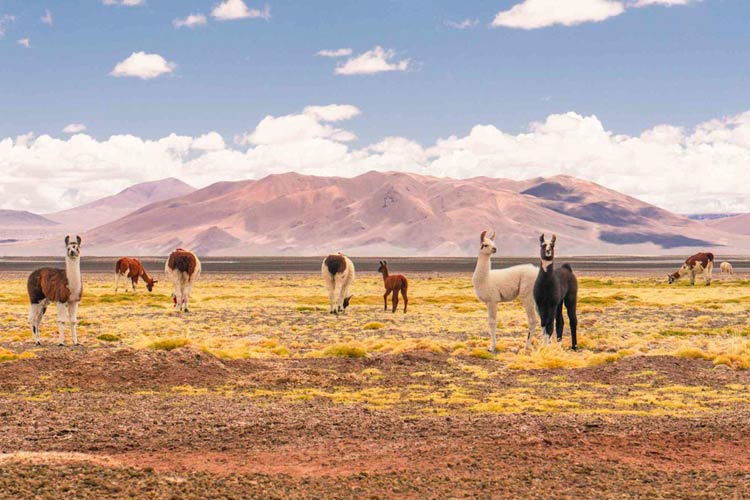
Human Presence in the Atacama
From Prehistoric Trails to Cosmic Ambitions
The Atacama Desert, although seemingly hostile to life, has attracted people for centuries – first as a home for ancient cultures, later as a stage for scientific and industrial conquests. In this barren landscape, humankind has left traces of its presence, from mysterious geoglyphs to gleaming mines and telescopes that gaze at the stars. It is a story of perseverance, a struggle against nature, and unceasing curiosity.
The Beginnings of Human Presence
The earliest inhabitants of the Atacama, such as the Chinchorro people, appeared here over 7,000 years ago, leaving behind some of the oldest mummies in the world – preserved not by intentional practices, but by the dry climate and salt of the desert. They lived along the coast, fishing and gathering shells, and their traces – from tools to ritual burials – still emerge from the sand, like ghosts of the past. Later, in pre-Columbian times, tribes such as the Atacameño traversed the interior, creating oases in places like San Pedro de Atacama and trading with distant cultures, from the Andes to the Amazon.
The Arrival of the Spanish and the Exploration of Resources
With the arrival of the Spanish in the 16th century, the desert became a field of exploitation. Saltpeter, known as “white gold,” attracted fortune seekers, and the now-abandoned mining towns, like Humberstone, stand as monuments to an era of boom and bust. Today, the Atacama is the heart of the Chilean mining industry – copper and lithium mines, powering global technology, sculpt its surface, leaving scars visible from space.
Astronomers
But it is not only raw materials that attract people here – the clear, cloudless skies have made the desert a mecca for astronomers. Facilities such as ALMA (Atacama Large Millimeter/submillimeter Array) and the under-construction Extremely Large Telescope are human eyes turned towards the stars, utilizing the unique conditions of the Atacama to study the origins of the universe.
Travelers
The people of the Atacama also include travelers and artists, inspired by its raw beauty. In the Moon Valley, tourists climb dunes at sunset, and in oases like Huacachina, locals still cultivate the land, using underground springs. However, life here requires resilience – water is precious, and isolation is omnipresent. Modern settlements, such as Calama, are oases of civilization in a sea of sand, but even they struggle with dust and drought. The Atacama teaches humility, reminding us that humans are only guests here.
This desert is not just a backdrop for human activities, but also a mirror reflecting our history and ambitions. From prehistoric hunters to scientists dreaming of space, the Atacama remains a place where human will confronts the power of nature. Whether it is a laboratory of the past or the future of exploration, one thing is certain: humans will never stop returning here.
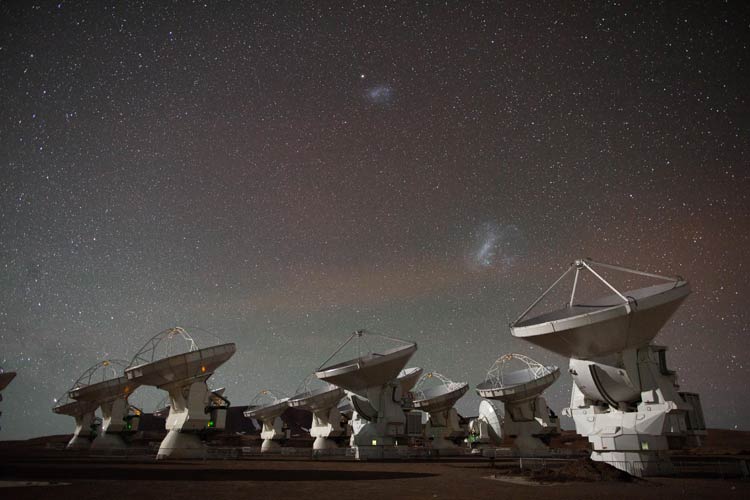
Astronomical Observatories in the Atacama
Windows to the Universe
In the heart of the Atacama Desert, where the sky stretches like an endless black veil dotted with stars, humankind has erected its most powerful tools for studying the cosmos. Thanks to the unique conditions – cloudless skies for over 300 nights a year, minimal light pollution, and dry air that does not scatter waves – the Atacama has become the global capital of astronomy. These observatories are more than just buildings; they are human dreams embodied in steel and glass, reaching towards the mysteries of the universe.
ALMA
The most famous of these is ALMA (Atacama Large Millimeter/submillimeter Array), located on the Chajnantor plateau at an altitude of 5,000 meters (16,404 feet). It is a collection of 66 precisely synchronized antennas that work as one giant telescope, capturing millimeter and submillimeter waves emitted by distant galaxies, stars being born in clouds of dust, and the cold remnants of the Big Bang. In 2019, ALMA helped capture data that supported the first-ever image of a black hole – a breakthrough that shook the scientific world. The staff, struggling with thin air and isolation, joke that they are closer to the stars than to civilization.
VLT
Nearby, on Cerro Paranal, rises the VLT (Very Large Telescope), four powerful optical telescopes, each with a mirror diameter of 8.2 meters (26.9 feet). Their names – Antu, Kueyen, Melipal, and Yepun – come from the Mapuche language and mean celestial bodies, paying homage to the local culture. The VLT can discern details billions of light-years away, such as exploding supernovae and planets orbiting other stars, and in 2018 it helped confirm Einstein’s theory of the curvature of spacetime. 3 At night, when lasers shoot out from the telescopes, creating artificial stars for calibration, the landscape looks like a scene from a science fiction movie.
ELT
The future looks even more spectacular: the ELT (Extremely Large Telescope) is under construction, and with a mirror diameter of 39 meters (128 feet), it is expected to be the largest optical telescope in the world. Once completed in 2027, it will allow us to peer into the darkness of the first galaxies formed after the Big Bang and perhaps answer the question of whether we are alone in the universe. The Atacama, with its silence and harshness, provides ideal conditions for these giants – the lack of moisture protects the equipment, and the altitude minimizes atmospheric disturbances.
The observatories in the Atacama are not just scientific fortresses – they are a symbol of human curiosity, which in this desert corner of the Earth has found its window to the cosmos. Every discovery from here – from the birth of stars to distant planets – reminds us that even in the most inhospitable place, one can reach for the stars. For astronomers, the Atacama is holy ground, where the night sky tells stories older than time.
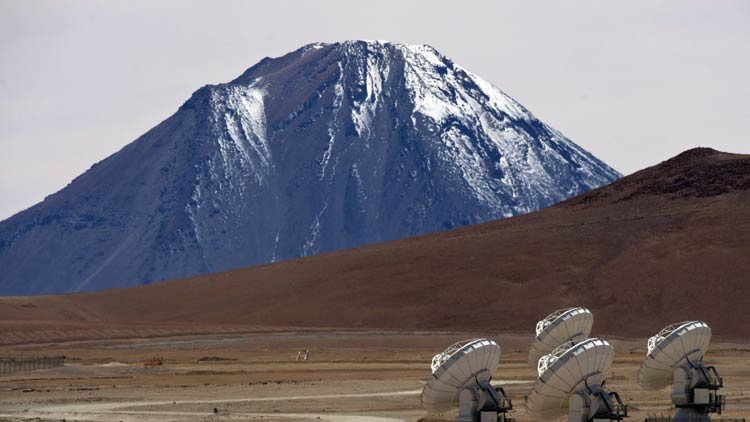
Atacama Desert in Numbers
- Atacama Desert is not only raw beauty but also fascinating statistics that reflect its uniqueness. Here is the Atacama in a nutshell:
- Area: 105,000 square kilometers (40,541 square miles), encompassing a narrow strip of Chile and fragments of Peru and Bolivia.
- Length: 1,100 km (684 miles), from southern Peru to central Chile. Some sources also include adjacent areas – Chala, Altiplano, Puna de Atacama, and Norte Chico – giving a length of 2,600 km (1,616 miles).
- Width: up to 100 km (62 miles) (180 km/112 miles with adjacent areas as above), trapped between the Andes and the Pacific Ocean.
- It lies within the territory of 3 countries, although most belongs to Chile – from the coast to the plateaus of the Andes.
- In some regions, such as the area around Arica, it has not rained for over 400 years, making it the driest place on Earth.
- The average annual rainfall in the interior is less than 1 millimeter (0.04 inches) – one hundred times less than in the Sahara.
- Volcanic cones, like Licancabur, rise to 5,916 meters (19,409 feet), towering over the desert.
- Temperatures in the Atacama Desert are low compared to similar latitudes in other places on Earth. The average temperature in summer in Iquique is only 19°C (66°F), and in Antofagasta 18°C (64°F).

Curiosities – Secrets of the Atacama
The Atacama Desert holds secrets that amaze and ignite the imagination. Here are a few of them:
- “Ata” Mummy – A Cosmic Enigma
In 2003, in the abandoned town of La Noria, a 15-centimeter (5.9 inches) mummy with an elongated skull was found, sparking theories of extraterrestrial origin. Studies have shown that it is human remains with genetic mutations, but its unusual appearance still stirs emotions. - The World’s Largest Radiotelescopes
The Atacama is home to ALMA – a complex of radio telescopes that, thanks to the clear skies, studies the origins of the universe. It is here that scientists capture waves from billions of years ago, peering into the cosmic past. - Geoglyphs Older Than Nazca
On the slopes of the desert hills, pre-Columbian drawings are visible – figures of people and animals, created by ancient cultures. Their purpose remains a mystery, but they are a testament to life in this harsh world. - Moon Valley – Another World
Valle de la Luna (Moon Valley) is a place where wind and salt have formed a landscape resembling the surface of the Moon. At sunset, the dunes and rocks take on surreal colors, attracting dreamers. - Desert Wrecks and Forgotten Towns
In Humberstone and Santa Laura stand abandoned mining settlements, relics of the 19th-century saltpeter boom. Their rusted machinery and empty streets tell stories of a bygone gold rush. - The Oldest Mummies on Earth
The Chinchorro culture mummified their dead 2,000 years before the Egyptians, and the dry climate of the Atacama has preserved their bodies in incredible condition. It is a natural open-air museum. - Lithium for the Future
The Atacama supplies over 30% of the world’s lithium, used in batteries for phones and electric cars. Its deposits power technology, but extraction leaves a mark on the delicate ecosystem.
The Atacama Desert is more than just a place on the map. It is a laboratory of nature, a gallery of geological wonders, and a mirror reflecting our curiosity about the universe. Standing on its cracked earth, you feel like you are on the border of Earth and space – in a place where life fights, and silence tells stories older than humanity. Do you dare to discover it?
